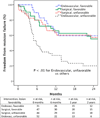Open surgical revision provides a more durable repair than endovascular treatment for unfavorable vein graft lesions
- PMID: 26483000
- PMCID: PMC4698070
- DOI: 10.1016/j.jvs.2015.08.065
Open surgical revision provides a more durable repair than endovascular treatment for unfavorable vein graft lesions
Abstract
Objective: Lower extremity bypass grafts that develop stenoses are commonly treated with either open surgical or endovascular revision. Vein graft stenoses with unfavorable lesions (multiple lesions, lesions >2 cm in length, lesions in grafts <3 months old, lesions in grafts <3 mm in diameter) fare worse than those with favorable lesions when treated with endovascular therapy. However, it is not known if unfavorable lesions fare better with surgical revision than with endovascular treatment or than favorable lesions treated with surgery.
Methods: We performed a retrospective review of 175 vein graft revisions performed at a single institution from 2000 to 2010. Characteristics of lesions treated with surgical and endovascular revision were identified. Cox proportional hazard models were used to identify predictors of revision failure (restenosis >75%, revision, or amputation).
Results: Ninety-one failing vein grafts (52%) were treated with surgical revision and 84 with endovascular treatment (48%), with a median follow-up of 30 months. Favorable lesions fared better than unfavorable lesions after endovascular treatment, with 12-month freedom from failure of 59% vs 34% (P < .01), but not after surgical revision (66% vs 62%; P = .90). Unfavorable lesions had better freedom from failure after surgery than endovascular treatment (62% vs 34%; P < .01), and results in favorable lesions were similar (66% vs 59%; P = .57).
Conclusions: For the treatment of failing vein grafts, endovascular therapy appears adequate for favorable lesions and surgical revision is more durable for unfavorable lesions.
Copyright © 2016 Society for Vascular Surgery. Published by Elsevier Inc. All rights reserved.
Figures
References
-
- Oresanya L, Makam AN, Belkin M, Moneta GL, Conte MS. Factors associated with primary vein graft occlusion in a multicenter trial with mandated ultrasound surveillance. J Vasc Surg. 2014;59:996–1002. - PubMed
-
- Tinder CN, Chavanpun JP, Bandyk DF, Armstrong PA, Back MR, Johnson BL, et al. Efficacy of duplex ultrasound surveillance after infrainguinal vein bypass may be enhanced by identification of characteristics predictive of graft stenosis development. J Vasc Surg. 2008;48:613–618. - PubMed
-
- Avino AJ, Bandyk DF, Gonsalves AJ, Johnson BL, Black TJ, Zwiebel BR, et al. Surgical and endovascular intervention for infrainguinal vein graft stenosis. J Vasc Surg. 1999;29:60–70. discussion -1. - PubMed
-
- Gonsalves C, Bandyk DF, Avino AJ, Johnson BL. Duplex features of vein graft stenosis and the success of percutaneous transluminal angioplasty. J Endovasc Surg. 1999;6:66–72. - PubMed
-
- Berceli SA. Revision of vein bypass grafts: factors affecting durability of interventions. Semin Vasc Surg. 2009;22:261–266. - PubMed
Publication types
MeSH terms
Grants and funding
LinkOut - more resources
Full Text Sources
Other Literature Sources
Medical


